Ding Zou
EmbodiedBrain: Expanding Performance Boundaries of Task Planning for Embodied Intelligence
Oct 23, 2025Abstract:The realization of Artificial General Intelligence (AGI) necessitates Embodied AI agents capable of robust spatial perception, effective task planning, and adaptive execution in physical environments. However, current large language models (LLMs) and multimodal LLMs (MLLMs) for embodied tasks suffer from key limitations, including a significant gap between model design and agent requirements, an unavoidable trade-off between real-time latency and performance, and the use of unauthentic, offline evaluation metrics. To address these challenges, we propose EmbodiedBrain, a novel vision-language foundation model available in both 7B and 32B parameter sizes. Our framework features an agent-aligned data structure and employs a powerful training methodology that integrates large-scale Supervised Fine-Tuning (SFT) with Step-Augumented Group Relative Policy Optimization (Step-GRPO), which boosts long-horizon task success by integrating preceding steps as Guided Precursors. Furthermore, we incorporate a comprehensive reward system, including a Generative Reward Model (GRM) accelerated at the infrastructure level, to improve training efficiency. For enable thorough validation, we establish a three-part evaluation system encompassing General, Planning, and End-to-End Simulation Benchmarks, highlighted by the proposal and open-sourcing of a novel, challenging simulation environment. Experimental results demonstrate that EmbodiedBrain achieves superior performance across all metrics, establishing a new state-of-the-art for embodied foundation models. Towards paving the way for the next generation of generalist embodied agents, we open-source all of our data, model weight, and evaluating methods, which are available at https://zterobot.github.io/EmbodiedBrain.github.io.
Boosting the Generalization and Reasoning of Vision Language Models with Curriculum Reinforcement Learning
Mar 10, 2025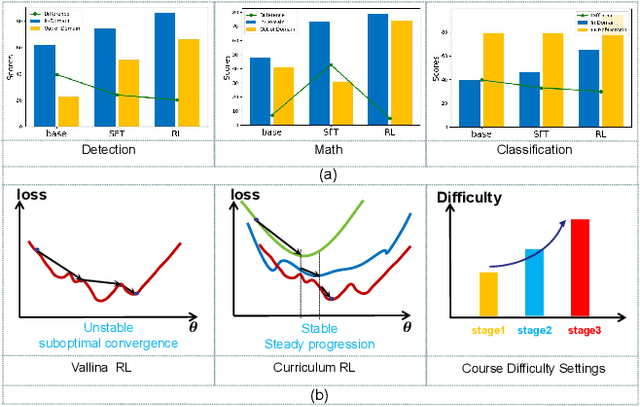
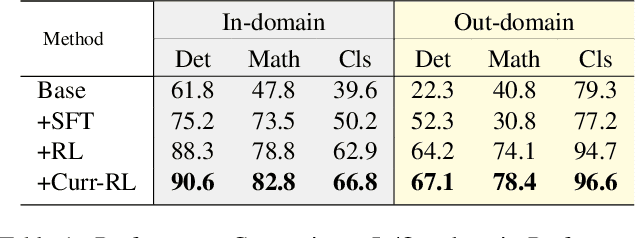
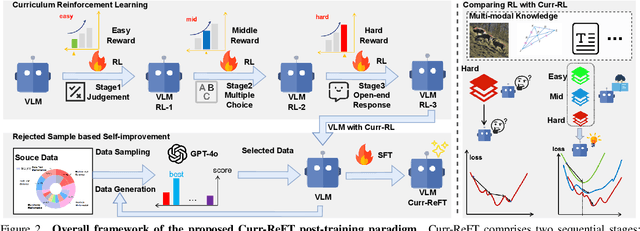
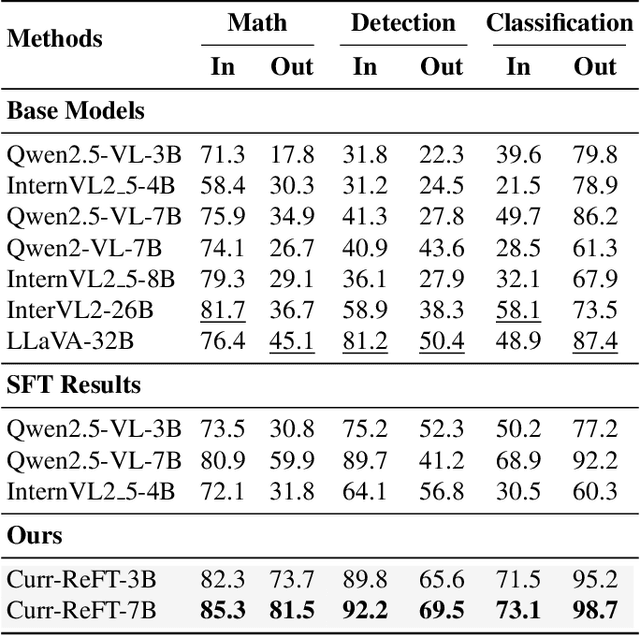
Abstract:While state-of-the-art vision-language models (VLMs) have demonstrated remarkable capabilities in complex visual-text tasks, their success heavily relies on massive model scaling, limiting their practical deployment. Small-scale VLMs offer a more practical alternative but face significant challenges when trained with traditional supervised fine-tuning (SFT), particularly in two aspects: out-of-domain (OOD) generalization and reasoning abilities, which significantly lags behind the contemporary Large language models (LLMs). To address these challenges, we propose Curriculum Reinforcement Finetuning (Curr-ReFT), a novel post-training paradigm specifically designed for small-scale VLMs. Inspired by the success of reinforcement learning in LLMs, Curr-ReFT comprises two sequential stages: (1) Curriculum Reinforcement Learning, which ensures steady progression of model capabilities through difficulty-aware reward design, transitioning from basic visual perception to complex reasoning tasks; and (2) Rejected Sampling-based Self-improvement, which maintains the fundamental capabilities of VLMs through selective learning from high-quality multimodal and language examples. Extensive experiments demonstrate that models trained with Curr-ReFT paradigm achieve state-of-the-art performance across various visual tasks in both in-domain and out-of-domain settings. Moreover, our Curr-ReFT enhanced 3B model matches the performance of 32B-parameter models, demonstrating that efficient training paradigms can effectively bridge the gap between small and large models.
Knowledge Enhanced Multi-intent Transformer Network for Recommendation
May 31, 2024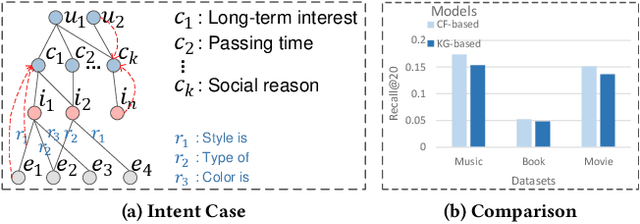
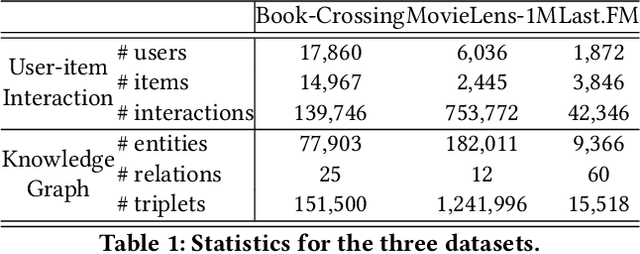

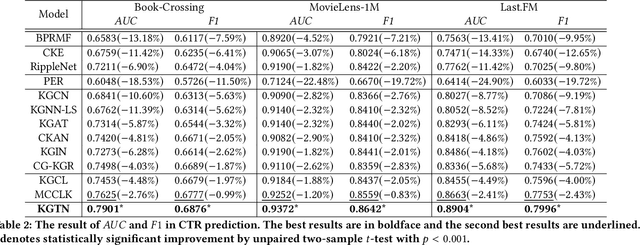
Abstract:Incorporating Knowledge Graphs into Recommendation has attracted growing attention in industry, due to the great potential of KG in providing abundant supplementary information and interpretability for the underlying models. However, simply integrating KG into recommendation usually brings in negative feedback in industry, due to the ignorance of the following two factors: i) users' multiple intents, which involve diverse nodes in KG. For example, in e-commerce scenarios, users may exhibit preferences for specific styles, brands, or colors. ii) knowledge noise, which is a prevalent issue in Knowledge Enhanced Recommendation (KGR) and even more severe in industry scenarios. The irrelevant knowledge properties of items may result in inferior model performance compared to approaches that do not incorporate knowledge. To tackle these challenges, we propose a novel approach named Knowledge Enhanced Multi-intent Transformer Network for Recommendation (KGTN), comprising two primary modules: Global Intents Modeling with Graph Transformer, and Knowledge Contrastive Denoising under Intents. Specifically, Global Intents with Graph Transformer focuses on capturing learnable user intents, by incorporating global signals from user-item-relation-entity interactions with a graph transformer, meanwhile learning intent-aware user/item representations. Knowledge Contrastive Denoising under Intents is dedicated to learning precise and robust representations. It leverages intent-aware representations to sample relevant knowledge, and proposes a local-global contrastive mechanism to enhance noise-irrelevant representation learning. Extensive experiments conducted on benchmark datasets show the superior performance of our proposed method over the state-of-the-arts. And online A/B testing results on Alibaba large-scale industrial recommendation platform also indicate the real-scenario effectiveness of KGTN.
Improving Knowledge-aware Recommendation with Multi-level Interactive Contrastive Learning
Aug 22, 2022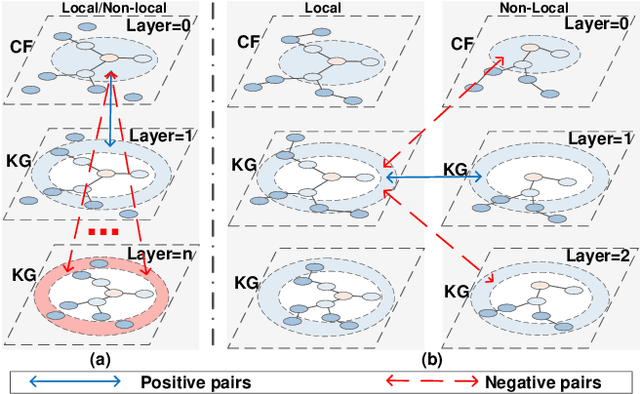
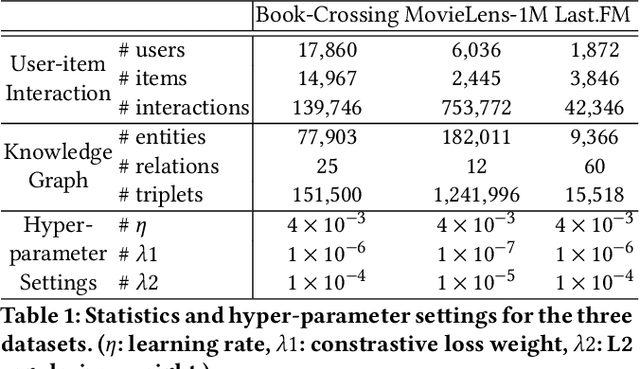


Abstract:Incorporating Knowledge Graphs (KG) into recommeder system has attracted considerable attention. Recently, the technical trend of Knowledge-aware Recommendation (KGR) is to develop end-to-end models based on graph neural networks (GNNs). However, the extremely sparse user-item interactions significantly degrade the performance of the GNN-based models, as: 1) the sparse interaction, means inadequate supervision signals and limits the supervised GNN-based models; 2) the combination of sparse interactions (CF part) and redundant KG facts (KG part) results in an unbalanced information utilization. Besides, the GNN paradigm aggregates local neighbors for node representation learning, while ignoring the non-local KG facts and making the knowledge extraction insufficient. Inspired by the recent success of contrastive learning in mining supervised signals from data itself, in this paper, we focus on exploring contrastive learning in KGR and propose a novel multi-level interactive contrastive learning mechanism. Different from traditional contrastive learning methods which contrast nodes of two generated graph views, interactive contrastive mechanism conducts layer-wise self-supervised learning by contrasting layers of different parts within graphs, which is also an "interaction" action. Specifically, we first construct local and non-local graphs for user/item in KG, exploring more KG facts for KGR. Then an intra-graph level interactive contrastive learning is performed within each graph, which contrasts layers of the CF and KG parts, for more consistent information leveraging. Besides, an inter-graph level interactive contrastive learning is performed between the local and non-local graphs, for sufficiently and coherently extracting non-local KG signals. Extensive experiments conducted on three benchmark datasets show the superior performance of our proposed method over the state-of-the-arts.
Multi-level Cross-view Contrastive Learning for Knowledge-aware Recommender System
Apr 19, 2022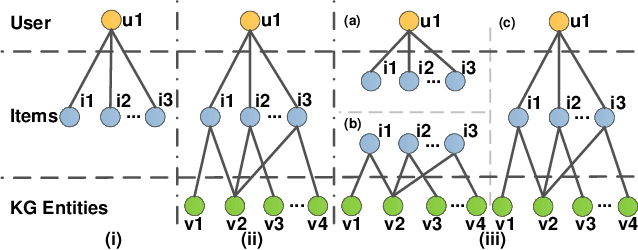
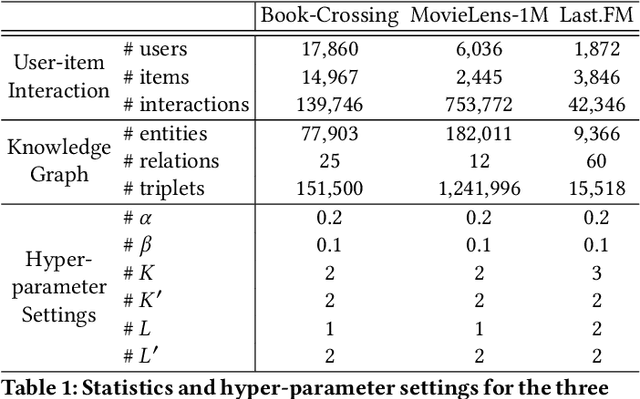
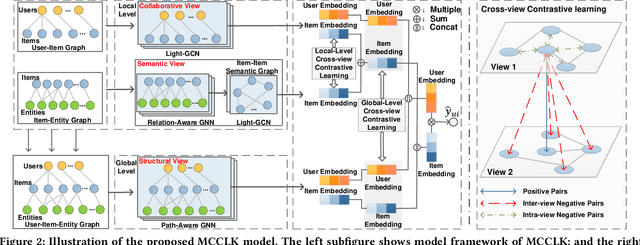

Abstract:Knowledge graph (KG) plays an increasingly important role in recommender systems. Recently, graph neural networks (GNNs) based model has gradually become the theme of knowledge-aware recommendation (KGR). However, there is a natural deficiency for GNN-based KGR models, that is, the sparse supervised signal problem, which may make their actual performance drop to some extent. Inspired by the recent success of contrastive learning in mining supervised signals from data itself, in this paper, we focus on exploring the contrastive learning in KG-aware recommendation and propose a novel multi-level cross-view contrastive learning mechanism, named MCCLK. Different from traditional contrastive learning methods which generate two graph views by uniform data augmentation schemes such as corruption or dropping, we comprehensively consider three different graph views for KG-aware recommendation, including global-level structural view, local-level collaborative and semantic views. Specifically, we consider the user-item graph as a collaborative view, the item-entity graph as a semantic view, and the user-item-entity graph as a structural view. MCCLK hence performs contrastive learning across three views on both local and global levels, mining comprehensive graph feature and structure information in a self-supervised manner. Besides, in semantic view, a k-Nearest-Neighbor (kNN) item-item semantic graph construction module is proposed, to capture the important item-item semantic relation which is usually ignored by previous work. Extensive experiments conducted on three benchmark datasets show the superior performance of our proposed method over the state-of-the-arts. The implementations are available at: https://github.com/CCIIPLab/MCCLK.
Multi-view Intent Disentangle Graph Networks for Bundle Recommendation
Feb 23, 2022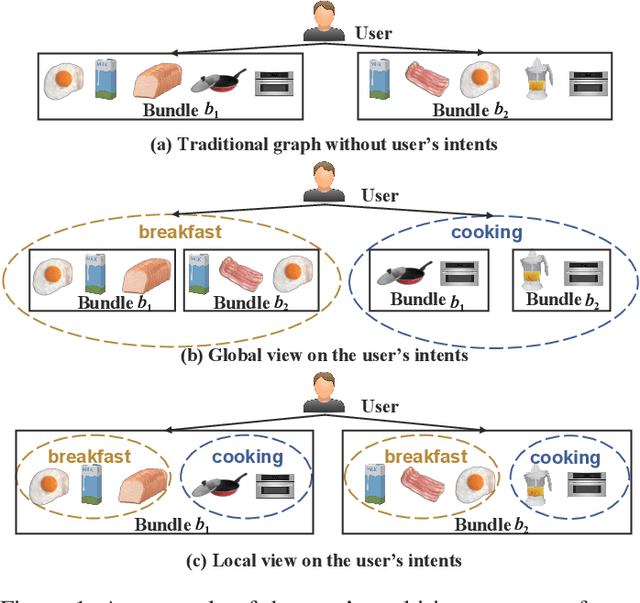
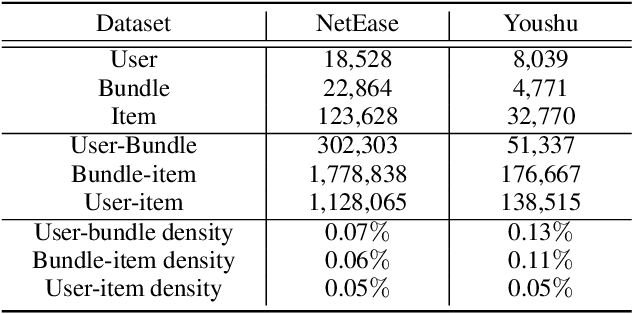
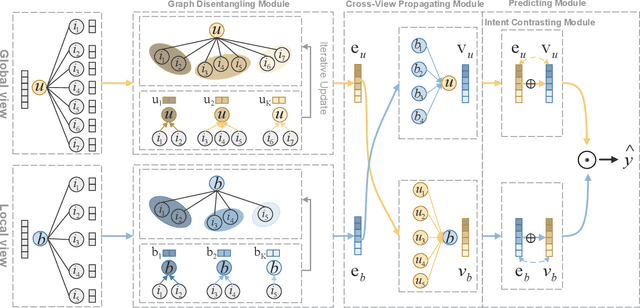
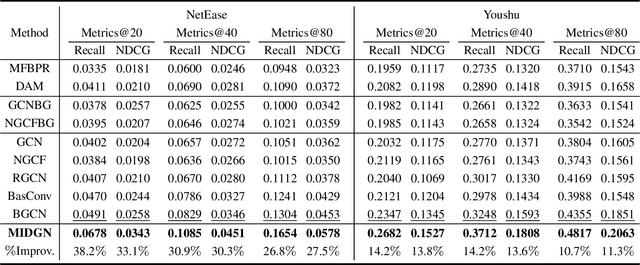
Abstract:Bundle recommendation aims to recommend the user a bundle of items as a whole. Nevertheless, they usually neglect the diversity of the user's intents on adopting items and fail to disentangle the user's intents in representations. In the real scenario of bundle recommendation, a user's intent may be naturally distributed in the different bundles of that user (Global view), while a bundle may contain multiple intents of a user (Local view). Each view has its advantages for intent disentangling: 1) From the global view, more items are involved to present each intent, which can demonstrate the user's preference under each intent more clearly. 2) From the local view, it can reveal the association among items under each intent since items within the same bundle are highly correlated to each other. To this end, we propose a novel model named Multi-view Intent Disentangle Graph Networks (MIDGN), which is capable of precisely and comprehensively capturing the diversity of the user's intent and items' associations at the finer granularity. Specifically, MIDGN disentangles the user's intents from two different perspectives, respectively: 1) In the global level, MIDGN disentangles the user's intent coupled with inter-bundle items; 2) In the Local level, MIDGN disentangles the user's intent coupled with items within each bundle. Meanwhile, we compare the user's intents disentangled from different views under the contrast learning framework to improve the learned intents. Extensive experiments conducted on two benchmark datasets demonstrate that MIDGN outperforms the state-of-the-art methods by over 10.7% and 26.8%, respectively.
 Add to Chrome
Add to Chrome Add to Firefox
Add to Firefox Add to Edge
Add to Edge